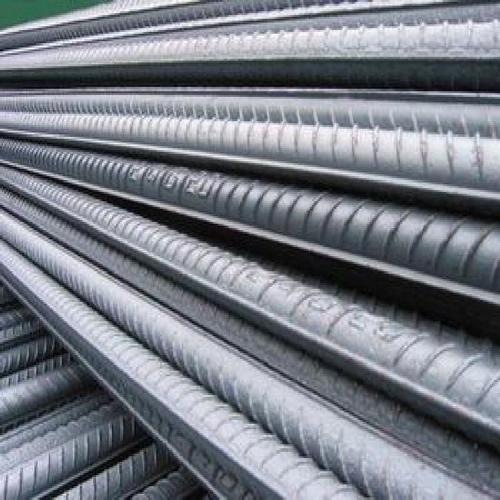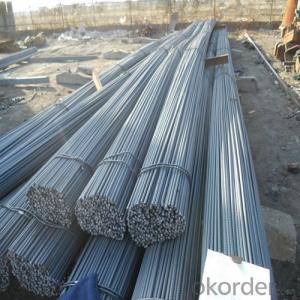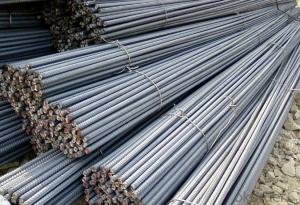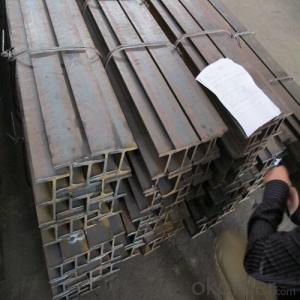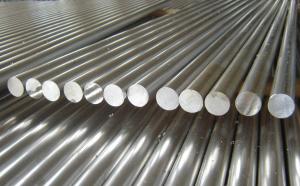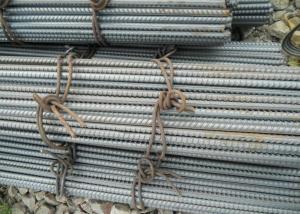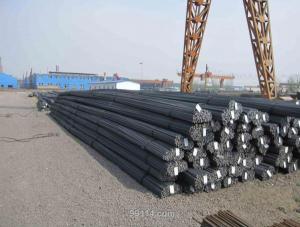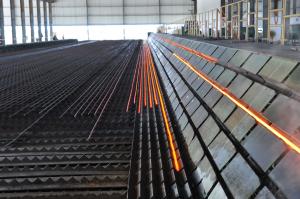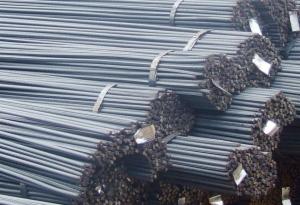Deformed Bar HRB335 HRB400 Hot Rolled High Quality 6mm-50mm
- Loading Port:
- China Main Port
- Payment Terms:
- TT or LC
- Min Order Qty:
- -
- Supply Capability:
- -
OKorder Service Pledge
OKorder Financial Service
You Might Also Like
Product Description:
OKorder is offering Deformed Bar HRB335 HRB400 Hot Rolled High Quality 6mm-50mmat great prices with worldwide shipping. Our supplier is a world-class manufacturer of steel, with our products utilized the world over. OKorder annually supplies products to European, North American and Asian markets. We provide quotations within 24 hours of receiving an inquiry and guarantee competitive prices.
Product Applications:
Deformed bar is widely used in buildings, bridges, roads and other engineering construction. Big to highways, railways, bridges, culverts, tunnels, public facilities such as flood control, dam, small to housing construction, beam, column, wall and the foundation of the plate, deformed bar is an integral structure material. With the development of world economy and the vigorous development of infrastructure construction, real estate, the demand for deformed bar will be larger and larger
Product Advantages:
OKorder's Deformed Bar HRB335 HRB400 Hot Rolled High Quality 6mm-50mm are durable, strong, and resist corrosion, exact size, regular package, chemical and mechanical properties are stable.
Main Product Features:
· Premium quality
· Prompt delivery & seaworthy packing (30 days after receiving deposit)
· Corrosion resistance
· Can be recycled and reused
· Mill test certification
· Professional Service
· Competitive pricing
Product Specifications:
Manufacture: Hot rolled
Grade: BS4449
Certificates: ISO, SGS, BV, CIQ
Diameter: 6mm,8mm,10mm,12mm,14mm,16mm,18mm,20mm,
22mm,25mm,28mm,32mm,36mm,40mm,50mm
Length: 6M, 9M,12M or as required
Packaging: Export packing, nude packing, bundled
Chemical Composition: (Please kindly find our chemistry of our material based on HRB500 as below for your information)
Grade | Technical data of the original chemical composition (%) | ||||||
C | Mn | Si | S | P | V | ||
HRB400 | ≤0.25 | ≤1.60 | ≤0.80 | ≤0.045 | ≤0.045 | 0.04-0.12 | |
Physical capability | |||||||
Yield Strength (N/cm²) | Tensile Strength (N/cm²) | Elongation (%) | |||||
≥400 | ≥570 | ≥14 | |||||
Theoretical weight and section area of each diameter as below for your information:
Diameter(mm) | Section area (mm²) | Mass(kg/m) | Weight of 12m bar(kg) |
6 | 28.27 | 0.222 | 2.664 |
8 | 50.27 | 0.395 | 4.74 |
10 | 78.54 | 0.617 | 7.404 |
12 | 113.1 | 0.888 | 10.656 |
14 | 153.9 | 1.21 | 14.52 |
16 | 201.1 | 1.58 | 18.96 |
18 | 254.5 | 2.00 | 24 |
20 | 314.2 | 2.47 | 29.64 |
22 | 380.1 | 2.98 | 35.76 |
25 | 490.9 | 3.85 | 46.2 |
28 | 615.8 | 4.83 | 57.96 |
32 | 804.2 | 6.31 | 75.72 |
36 | 1018 | 7.99 | 98.88 |
40 | 1257 | 9.87 | 118.44 |
50 | 1964 | 15.42 | 185.04 |
FAQ:
Q1: Why buy Materials & Equipment from OKorder.com?
A1: All products offered byOKorder.com are carefully selected from China's most reliable manufacturing enterprises. Through its ISO certifications, OKorder.com adheres to the highest standards and a commitment to supply chain safety and customer satisfaction.
Q2: How do we guarantee the quality of our products?
A2: We have established an advanced quality management system which conducts strict quality tests at every step, from raw materials to the final product. At the same time, we provide extensive follow-up service assurances as required.
Q3: How soon can we receive the product after purchase?
A3: Within three days of placing an order, we will begin production. The specific shipping date is dependent upon international and government factors, but is typically 7 to 10 workdays.
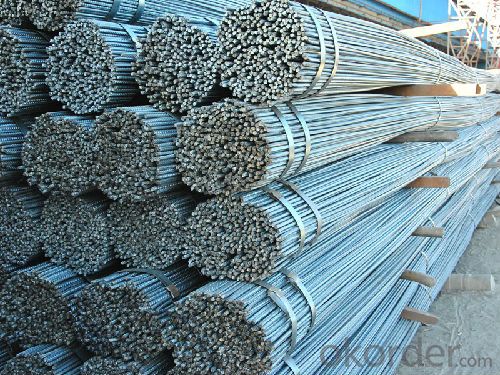
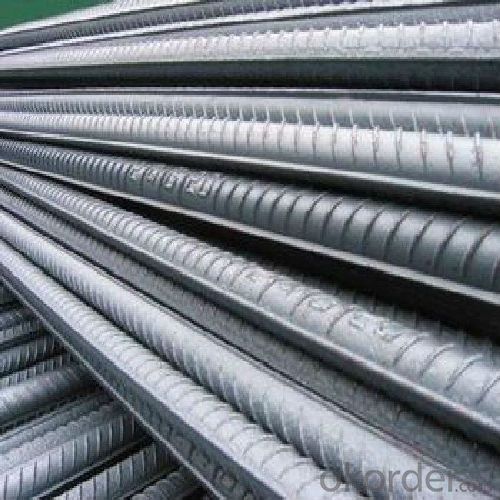
- Q: How do steel rebars affect the overall crack control of concrete?
- Steel rebars can significantly enhance the crack control of concrete. By providing tensile strength to the concrete, rebars help distribute and resist the formation of cracks. They act as reinforcement, preventing cracks from propagating and limiting their width, thus enhancing the overall durability and structural integrity of the concrete.
- Q: Are steel rebars easy to work with?
- The ease or difficulty of working with steel rebars depends on the task at hand and the level of experience and skill of the individual. Generally, steel rebars are valued for their strength and durability, making them a popular choice in construction projects. Their standardized sizes and uniform shape make them relatively easy to handle and manipulate. However, caution and specific techniques are required when working with steel rebars. The physical demands of cutting and bending rebars may necessitate the use of specialized tools like rebar cutters and benders. Additionally, the weight of rebars, especially longer and thicker ones, can pose a challenge. Moreover, safety precautions are essential when working with steel rebars. Wearing protective gear such as gloves and goggles is crucial to prevent injuries. It is also necessary to be mindful of potential hazards like sharp edges and protruding rebars. In conclusion, while experienced professionals may find working with steel rebars relatively easy, individuals with limited knowledge or tools may face challenges. It is advisable to seek proper training and guidance to ensure safety and achieve accurate results.
- Q: What is the process of connecting steel rebars to structural members?
- To establish a secure and dependable connection, several steps are involved in connecting steel rebars to structural members. To begin with, the structural member's design specifications necessitate the precise positioning of the long, ridged or deformed steel bars called rebars. This is typically accomplished by using spacers or chairs to maintain the appropriate spacing between the rebars and the surrounding formwork. Following that, the rebars are connected to the structural member through various means. A common method is lap splicing, where the rebars overlap for a designated distance and are then tied together using wire or mechanical connectors. The length of the overlap is determined by engineering calculations to ensure adequate strength and load transfer. Another approach involves the use of pre-fabricated mechanical couplers, which provide a dependable connection between the rebars. These couplers are designed to securely grip the rebars and effectively transfer the load. They offer advantages such as quicker installation, reduced labor costs, and enhanced structural integrity. In addition to splicing, the rebars may also need to be anchored or hooked into the structural member. Anchoring involves extending the rebar's length beyond the connection point and bending it back into the concrete to create a hook shape. This provides additional resistance against pull-out forces. Throughout the process, it is crucial to ensure that the rebars are clean, free from rust, and properly aligned. Any contaminants or misalignments can weaken the connection and compromise the structural integrity. Therefore, comprehensive inspection and quality control measures are essential to ensure a successful connection. Overall, the process of connecting steel rebars to structural members requires meticulous planning, precise positioning, proper splicing or coupling, and thorough inspection. By following these steps, a robust and long-lasting connection can be achieved, guaranteeing the safety and stability of the structure.
- Q: What are the different corrosion protection methods for steel rebars?
- There are several corrosion protection methods available for steel rebars, which are commonly used in reinforced concrete structures. These methods aim to prevent or minimize the corrosion of the steel rebars, as corrosion can significantly weaken the overall structure. 1. Concrete Cover: The most common corrosion protection method is providing an adequate thickness of concrete cover over the steel rebars. The concrete acts as a physical barrier, preventing exposure of the rebars to corrosive elements. 2. Galvanization: Galvanizing involves coating the steel rebars with a layer of zinc. This protective layer acts as a sacrificial anode, corroding before the steel rebars. Galvanization significantly enhances the rebars' resistance to corrosion. 3. Epoxy Coating: Epoxy coating is a popular corrosion protection method where a layer of epoxy resin is applied over the steel rebars. The epoxy acts as a barrier, preventing moisture and corrosive substances from reaching the rebars. 4. Cathodic Protection: Cathodic protection is an electrochemical method that involves the application of a sacrificial anode or an impressed current system. In a sacrificial anode system, a more reactive metal, such as zinc or magnesium, is connected to the steel rebars, sacrificing itself and preventing corrosion. In an impressed current system, an external power source is used to provide a protective current to the rebars, preventing corrosion. 5. Corrosion Inhibitors: Corrosion inhibitors are chemicals added to the concrete mix or applied as a surface treatment to the rebars. These inhibitors form a protective film on the rebars' surface, preventing corrosion by blocking the access of corrosive agents. 6. Stainless Steel Rebars: Using stainless steel rebars is an effective corrosion protection method. Stainless steel has a high resistance to corrosion, making it suitable for structures exposed to aggressive environments. It is important to note that the selection of the appropriate corrosion protection method depends on various factors, including the environmental conditions, expected service life of the structure, and cost considerations. Additionally, regular inspection and maintenance of the corrosion protection system are essential to ensure its effectiveness over time.
- Q: How do steel rebars contribute to the overall safety of a structure?
- Steel rebars contribute to the overall safety of a structure by providing reinforcement and strength to concrete. They enhance the structural integrity, preventing cracking and failure under heavy loads or during seismic events. Steel rebars also help to distribute and absorb forces, improving the resistance against bending, shearing, and tension. By effectively reinforcing the concrete, steel rebars ensure the durability and longevity of the structure, minimizing the risk of collapse and ensuring the safety of occupants.
- Q: Can steel rebars be used in cold weather conditions?
- Cold weather conditions allow for the use of steel rebars. Steel is renowned for its durability and strength, rendering it a viable material for construction endeavors in frigid climates. Nevertheless, when employing steel rebars in cold weather, it is imperative to exercise certain precautions. For instance, it is vital to ensure that the rebars are stored and shielded adequately to prevent corrosion caused by moisture. Moreover, the concrete mixture utilized in conjunction with the rebars must be modified to withstand freezing temperatures and avert cracking. Ultimately, with meticulous planning and adherence to precautions, steel rebars can be employed effectively in cold weather conditions.
- Q: Can steel rebars be used in structures with limited construction technology?
- Yes, steel rebars can be used in structures with limited construction technology. Steel rebars are commonly used in construction to reinforce concrete structures, providing strength and durability. They are versatile and can be used in various types of structures, such as buildings, bridges, and dams. In areas with limited construction technology, the use of steel rebars can still be feasible. The basic process of placing rebars involves bending and cutting them to the required sizes and shapes, and then placing them within the concrete forms before pouring the concrete. This process can be carried out using basic tools and equipment that are typically available in construction sites with limited resources. Additionally, the availability of steel rebars in various sizes and grades allows for flexibility in design and construction, making them suitable for a wide range of structures. The use of steel rebars ensures that the concrete structure can withstand various loads and forces, enhancing its overall strength and durability. While the availability of advanced construction technology may enhance the efficiency and precision of the construction process, it is not a prerequisite for using steel rebars. With proper training and expertise, construction workers can effectively use steel rebars in structures, even with limited technology, to create safe and reliable structures.
- Q: Are there any specific guidelines for storing and handling steel rebars?
- Yes, there are specific guidelines for storing and handling steel rebars. Here are some important points to consider: 1. Storage: Steel rebars should be stored in a clean, dry, and well-ventilated area to prevent corrosion. They should be stacked on timber or other suitable materials to keep them off the ground and avoid contact with moisture. 2. Handling: Steel rebars should be handled with care to prevent any damage or bending. It is recommended to use appropriate equipment such as cranes, forklifts, or strong hooks to lift and move rebars. Avoid dragging or dropping them, as it can result in deformations and weaken their structural integrity. 3. Bundling: Rebars should be properly bundled and tied together using steel wires or straps to prevent them from rolling or shifting during storage or transportation. This ensures their stability and reduces the risk of accidents. 4. Separation: Different sizes and types of rebars should be separated and clearly labeled to avoid confusion during construction. This helps in easily identifying and using the required rebar as per the structural plans. 5. Protection: Rebars should be protected from exposure to moisture, rain, snow, and other weather elements. If rebars are stored outdoors, waterproof covers or tarps should be used to shield them and prevent rust formation. 6. Inspection: Regular inspections should be conducted to identify any signs of corrosion, damage, or bending. Any defective or compromised rebars should be removed and replaced to ensure the structural integrity of the construction project. 7. Transportation: During transportation, rebars should be securely fastened and loaded onto suitable vehicles to prevent movement or falling off. Adequate padding and tie-downs should be used to protect rebars from damage and ensure safe transportation. It is crucial to follow these guidelines to maintain the quality, durability, and safety of steel rebars throughout their storage and handling process.
- Q: Can steel rebars be used in historical buildings restoration?
- Yes, steel rebars can be used in historical buildings restoration. Steel rebars provide strength and structural integrity to the building, ensuring its stability and longevity. However, it is crucial to use rebars that are compatible with the historical building's materials and design to preserve its authenticity. Additionally, proper installation techniques and preservation methods should be employed to minimize any potential damage or alteration to the historical fabric of the building.
- Q: What are the common defects found in steel rebars?
- Steel rebars can exhibit several common defects. One such defect is surface cracks, which may arise from either the manufacturing process or mishandling and inadequate storage. These cracks have the potential to compromise the rebars' strength and integrity, thereby increasing the risk of failure under load. Another frequently encountered defect is corrosion, which occurs when rebars are exposed to moisture or chemicals. This corrosion weakens the rebars and diminishes their load-bearing capacity, rendering them more susceptible to failure. Bending and straightening defects are also commonly observed in steel rebars. Improper bending or straightening techniques can result in cracks, buckling, or uneven distribution of stress, thereby compromising the performance of the rebars. Inadequate welding or improper lapping of rebars can lead to subpar connections and reduced structural integrity. Welding defects, such as lack of fusion, incomplete penetration, or excessive porosity, weaken the rebars and heighten the risk of failure. Dimensional defects, encompassing variations in diameter, length, or straightness, can impact the fit and compatibility of rebars with other structural components. When rebars are not correctly aligned or fail to meet the required dimensions, it can lead to diminished structural strength and compromised performance. Lastly, improper heat treatment during the manufacturing process can result in internal defects like segregation, inclusions, or improper grain structure. These defects undermine the rebars' strength and render them more susceptible to fracture or failure under load. In summary, it is crucial to thoroughly inspect steel rebars for these common defects to ensure the structural integrity and safety of the construction projects in which they are employed.
Send your message to us
Deformed Bar HRB335 HRB400 Hot Rolled High Quality 6mm-50mm
- Loading Port:
- China Main Port
- Payment Terms:
- TT or LC
- Min Order Qty:
- -
- Supply Capability:
- -
OKorder Service Pledge
OKorder Financial Service
Similar products
Hot products
Hot Searches
Related keywords




